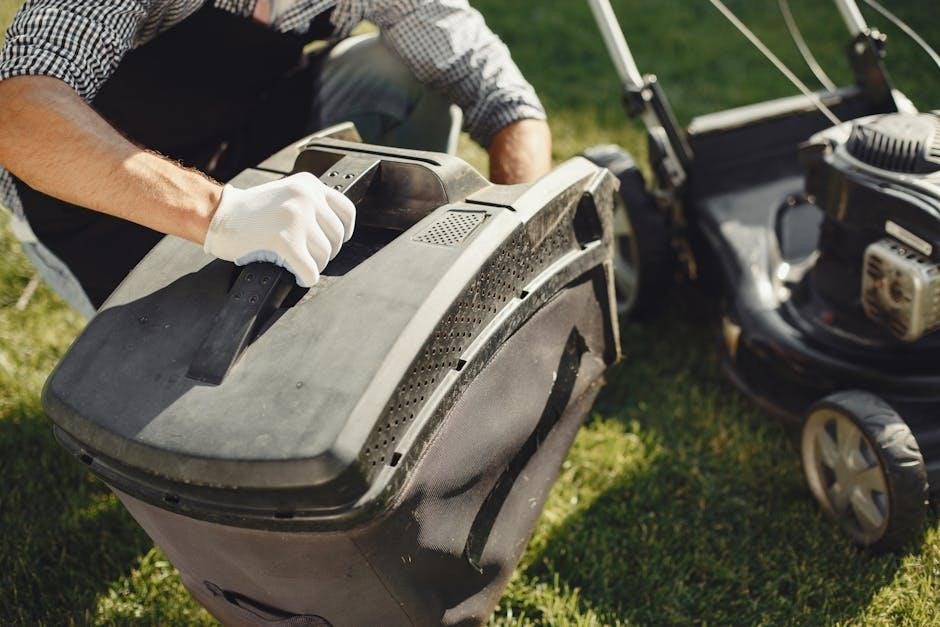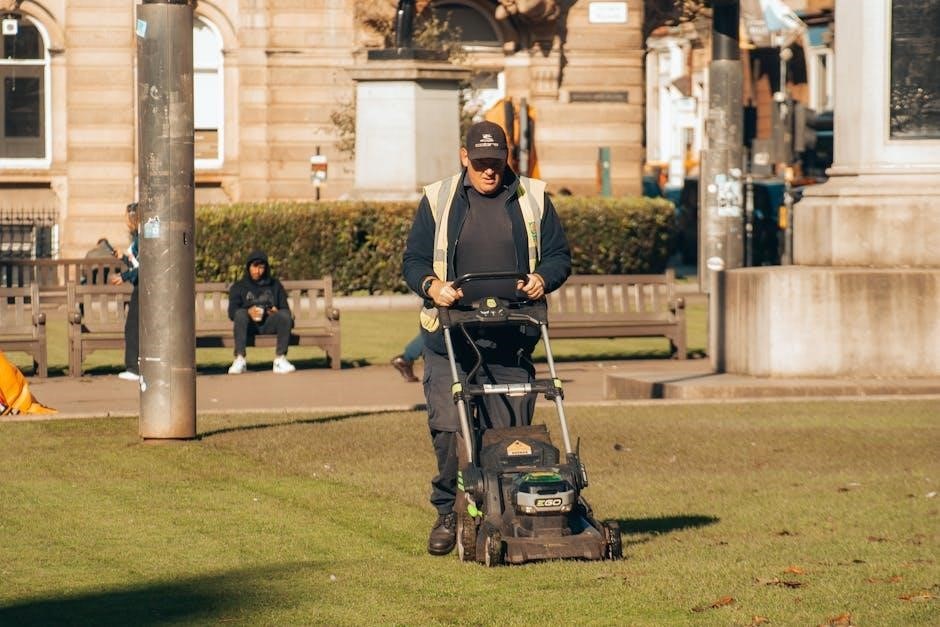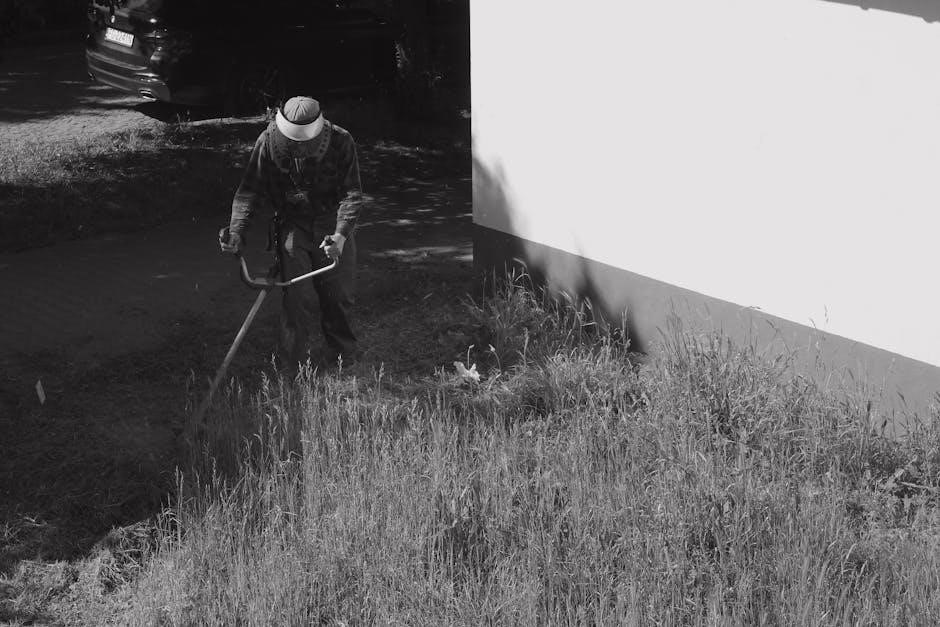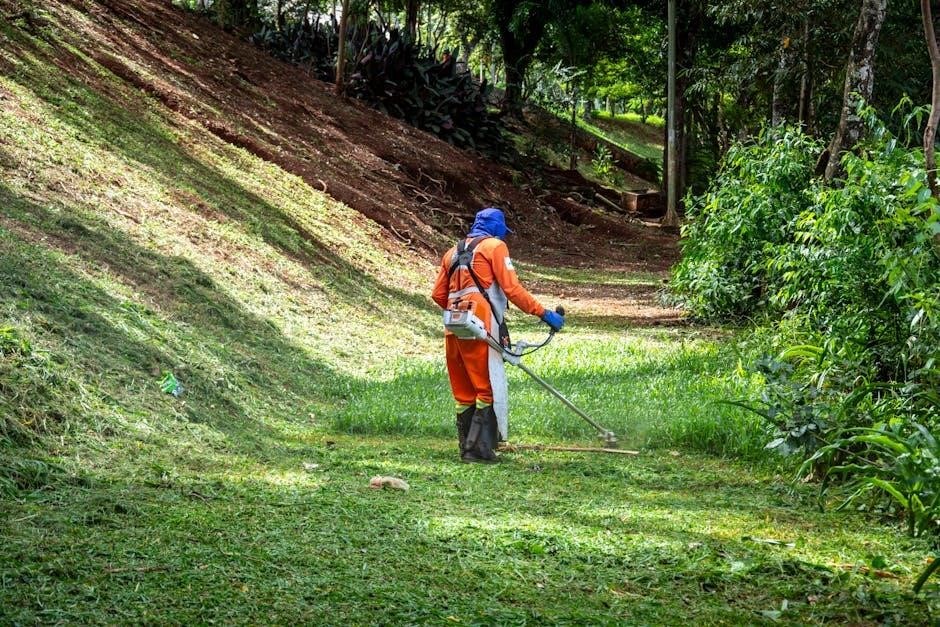This manual provides essential guidance for operating, maintaining, and troubleshooting your Craftsman riding lawn mower, ensuring safe and efficient use of the equipment.
1.1 Importance of the Manual
The Craftsman riding lawn mower manual is essential for understanding proper operation, safety guidelines, and maintenance procedures. It provides detailed instructions for assembly, troubleshooting, and repair, ensuring optimal performance and longevity of your mower. By following the manual, you can prevent accidents, reduce repair costs, and maintain warranty coverage. It also offers tips for eco-friendly practices and storage solutions. Referencing the manual regularly helps users resolve issues quickly and make informed decisions about parts and accessories. It serves as a comprehensive guide to maximize efficiency and safety while operating your Craftsman riding lawn mower effectively.
1.2 What’s Included in the Manual
The Craftsman riding lawn mower manual includes detailed sections on safety precautions, assembly steps, and operating instructions. It covers maintenance schedules, oil change procedures, and blade sharpening. Troubleshooting guides for common issues like engine failure and transmission problems are also provided. The manual lists genuine parts and accessories, along with warranty information. Additionally, it offers eco-friendly mowing tips and proper storage guidelines. Diagrams and part numbers are included for easy reference, ensuring users can identify and replace components efficiently. This comprehensive resource helps users understand and maintain their mower for optimal performance and longevity.

Safety Guidelines and Precautions
Always wear protective gear, ensure blades are disengaged, and follow pre-operation checks. Keep children away and avoid mowing in reverse. Adhere to safety rules for optimal protection and performance.
2.1 Pre-Operation Safety Checks
Before starting the mower, ensure all safety features are activated. Disengage the blades, check for loose parts, and verify the parking brake is engaged. Inspect the mowing area for obstacles and ensure the mower deck is clear of debris. Always wear protective gear, including gloves and eye protection. Check the tire pressure and ensure all controls function properly. Refer to the manual for specific pre-operation checks tailored to your model. These steps ensure a safe and efficient mowing experience, preventing potential hazards and maintaining optimal performance.
2.2 Protective Gear and Apparel
Always wear appropriate protective gear when operating a Craftsman riding lawn mower. Essential items include sturdy gloves to improve grip and protect hands, safety glasses or goggles to shield eyes from debris, and a hat or visor to block sunlight. Wear closed-toe, slip-resistant footwear for traction and stability. Hearing protection, such as earplugs, is recommended to guard against engine noise. Additionally, consider wearing long pants and a reflective vest for increased visibility. Proper attire ensures safety, reduces injury risks, and enhances comfort during operation. Always prioritize protective gear to maintain a safe mowing experience.
2.3 Operating Precautions
Always follow key safety practices while operating your Craftsman riding lawn mower. Ensure the mower deck is engaged only when moving forward and disengage it when approaching people or obstacles. Avoid mowing on steep slopes or uneven terrain to prevent tipping. Never allow children or pets near the mowing area. Keep loose clothing and long hair tied back to avoid entanglement. Be cautious of debris like rocks or branches, which can cause damage or injury. Maintain a steady speed and use extra caution when reversing. Stay alert to your surroundings and avoid distractions while operating the mower.

Assembly and Installation
Start by carefully unpacking and inventorying all components. Follow step-by-step assembly instructions for attaching handles, seats, and other parts. Ensure all bolts are securely tightened. Attachments like bags or mulching kits should be installed according to manufacturer guidelines. Double-check all connections before first use to ensure proper function and safety.
3.1 Unpacking and Inventory
Begin by carefully opening the crate or packaging to avoid damaging any components. Inspect all parts thoroughly for any signs of damage or missing items. Cross-reference the contents with the manual’s inventory list to ensure everything is included. Pay special attention to hardware like bolts, nuts, and cables. Organize smaller parts in a designated area to prevent misplacement. Verify that the mower’s frame, seat, and attachments are securely packaged and free from defects. Before proceeding with assembly, double-check that all components are accounted for and match the manual’s specifications. This step ensures a smooth assembly process and prevents delays.
3.2 Initial Assembly Steps
Start by attaching the seat, steering wheel, and mower deck according to the manual’s instructions. Ensure all bolts and nuts are tightened securely. Next, connect the battery terminals, making sure the positive and negative cables are correctly aligned. Fill the fuel tank with the recommended type of gasoline, but avoid overfilling. Check the tire pressure and adjust it to the specified levels. Finally, perform a test run by disengaging the PTO, setting the parking brake, and starting the engine to ensure all systems function properly. Refer to the manual for specific torque values and assembly sequences to guarantee safety and performance.
3.3 Attachments and Accessories
Your Craftsman riding lawn mower can be enhanced with various attachments and accessories to increase its functionality. Common additions include a bagger for grass clippings, a mulch kit for nutrient-rich cuttings, and a snow plow for winter use. Utility carts and trailers are also popular for hauling tools or debris. Always follow the manual’s installation guidelines to ensure proper fitment and safety. After attaching any accessory, check and adjust the mower deck height and tire pressure as needed. These enhancements can transform your mower into a versatile yard work companion, making tasks easier and more efficient year-round.

Operating the Lawn Mower
Start the engine, engage the transmission, and adjust the mower deck height before cutting. Use controls to steer and manage speed. Follow safety guidelines for efficient, safe operation.
4.1 Starting and Stopping the Engine
To start the engine, ensure the parking brake is engaged and the PTO is disengaged. Turn the key to the “start” position and activate the choke if needed. Allow the engine to warm up briefly before operation; To stop, disengage the PTO, move the throttle to the “slow” position, and turn the key to “off.” Always remove the key and engage the brake when leaving the mower unattended. Refer to your manual for specific procedures to ensure safe and proper engine operation.
4.2 Basic Controls and Functions
The Craftsman riding lawn mower features an ignition switch, throttle control, PTO engagement lever, and steering wheel. The ignition starts the engine, while the throttle adjusts speed. The PTO lever activates the mowing deck, and the steering wheel controls direction. Foot pedals manage acceleration, braking, and reversing. The parking brake ensures stability when stationary. Understanding these controls is crucial for safe and efficient operation. Always refer to the manual for specific instructions on using these functions properly to maintain control and ensure optimal performance while mowing.
4.3 Mowing Techniques and Tips
For efficient mowing, maintain a steady speed and follow a pattern to avoid missing spots. Adjust the mower deck height based on grass type and growth. Mow in straight lines, turning at the end of each pass. Avoid mowing in reverse unless necessary, as this can damage the mower. Keep the discharge chute directed away from people and pets to prevent debris hazards. Turn at slower speeds to maintain control and avoid tearing the grass. Regular blade sharpening ensures clean cuts and healthy lawn growth. Leave grass clippings on the lawn to act as a natural fertilizer. Always use the recommended fuel type for your mower to ensure optimal performance and longevity.

Maintenance and Servicing
Regular maintenance ensures optimal performance and longevity. Schedule routine checks, oil changes, blade sharpening, and tire pressure adjustments. Refer to the manual for specific guidelines and intervals.
5.1 Routine Maintenance Schedule
A well-structured maintenance schedule ensures your Craftsman riding lawn mower performs optimally. Regular tasks include oil changes every 50 hours, blade sharpening, and tire pressure checks; Additionally, inspect the air filter monthly and clean or replace it as needed. Check the mower deck for debris and ensure all belts are in good condition. Lubricate moving parts periodically to prevent wear. Consult the manual for specific intervals and procedures to maintain your mower’s efficiency and extend its lifespan. Proper maintenance prevents breakdowns and ensures safe operation throughout the mowing season.
5.2 Oil Change and Lubrication
Regular oil changes and proper lubrication are crucial for maintaining your Craftsman riding lawn mower. Start by warming the engine, then locate the oil drain plug and safely drain the old oil into a pan. Replace the oil filter with a new one and refill with the recommended oil type. Lubricate the mower deck pivot points and other moving parts to ensure smooth operation. Always refer to the manual for specific oil capacity and viscosity requirements. Proper lubrication prevents engine wear and keeps your mower running efficiently throughout the season. Regular oil changes also help extend the life of your equipment.
5.3 Blade Maintenance and Sharpening
Regular blade maintenance is essential for optimal cutting performance. Inspect blades for wear or damage and sharpen them every 25 hours of use. Disconnect the spark plug for safety before removing the blade. Use a grinder or file to sharpen the cutting edge to a 20-30 degree angle. Avoid overheating the blade during sharpening. After sharpening, balance the blade to prevent vibration. Replace blades if they are excessively worn or bent. Properly maintained blades ensure a clean cut, reduce mower strain, and promote healthy lawn growth. Always follow safety guidelines when handling sharp objects and refer to the manual for specific instructions.
5.4 Tire Pressure and Wheel Maintenance
Proper tire pressure ensures stability and optimal mowing performance. Check tire pressure before each use and after inflation, as specified in the owner’s manual. Inspect wheels regularly for wear, damage, or debris accumulation. Clean debris from wheel rims and axles to maintain smooth operation. Lubricate axle and wheel bearings as recommended to prevent friction and wear. Store the mower on a level surface to avoid tire distortion. Maintain correct tire pressure to prevent uneven tire wear and ensure consistent cutting height. Regular maintenance of tires and wheels enhances safety, performance, and extends the lifespan of your Craftsman riding lawn mower.

Troubleshooting Common Issues
This section helps identify and resolve common problems with your Craftsman riding lawn mower, guiding you through diagnosis, repair, and maintenance to keep your mower running smoothly.
6.1 Engine Not Starting
If your Craftsman riding lawn mower’s engine won’t start, check the ignition key is in the “on” position and the parking brake is disengaged. Ensure the PTO switch is off and the mower deck is not engaged. Verify the fuel tank has sufficient fuel and the choke is properly adjusted. Inspect the air filter for cleanliness and ensure the spark plug is functioning. If issues persist, consult the manual or contact a professional for further assistance. Always follow safety guidelines when diagnosing and repairing your mower.
6.2 Mower Deck Issues
Common issues with the mower deck include uneven cutting, blade damage, or improper height adjustment. Check if the deck is level and adjust as needed. Inspect blades for wear or damage; dull or bent blades should be replaced. Ensure the deck belt is tight and not slipping. If the deck vibrates excessively, check for loose bolts or imbalance. Clean debris regularly to maintain optimal performance. Refer to your manual for specific adjustment and maintenance procedures. Addressing these issues promptly will ensure a consistent and even cut, prolonging the life of your mower deck and overall machine performance.
6.3 Transmission and Steering Problems
Transmission issues may include difficulty shifting gears or lack of movement. Check the transmission fluid level and top it off if necessary. Inspect the belt for cracks or wear; replace it if damaged. Steering problems, such as uneven handling, could stem from misaligned wheels or low tire pressure. Ensure tires are inflated to the recommended pressure and wheels are properly aligned. If issues persist, consult the manual or contact a professional. Regular lubrication of moving parts and proper maintenance can prevent many transmission and steering problems, ensuring smooth operation and extending the lifespan of your Craftsman riding lawn mower.

Repair and Replacement
Address repairs promptly to maintain performance. DIY fixes are possible for minor issues, but complex problems may require professional assistance. Always use genuine replacement parts.
7.1 DIY Repair Tips
Address minor issues like blade sharpening, oil changes, and filter replacements yourself. Always disconnect the battery and ensure the mower is cool before starting repairs. For blade maintenance, remove the blade, sharpen it carefully, and rebalance it. Regularly check and replace the air filter to improve engine performance. Clean the mower deck to prevent rust and debris buildup. Lubricate moving parts like wheels and pivot points. Refer to your manual for specific instructions and safety precautions. Use genuine Craftsman parts for replacements to ensure compatibility and durability. DIY repairs can save time and money but always prioritize safety and proper techniques.
7.2 When to Call a Professional
Consult a professional for complex repairs like transmission issues, major engine problems, or electrical system malfunctions. If you’re unsure about a repair or lack the tools, seek expert help to avoid further damage or safety risks. For warranty-related issues, contact authorized Craftsman service centers to ensure repairs are covered. Professional technicians have the expertise and genuine parts to handle critical tasks, ensuring your mower operates safely and efficiently. DIY repairs are great for minor fixes, but for major problems, trusting a professional is the best choice to maintain performance and longevity of your Craftsman riding lawn mower.
7.3 Parts Replacement Guide
Refer to your Craftsman riding lawn mower manual for specific part numbers and diagrams. Always use genuine Craftsman parts to ensure compatibility and performance. Identify the exact part needed using the manual’s parts list or online resources like Sears Parts Direct. Before replacing, disconnect the battery and wear protective gear. Follow the manual’s step-by-step instructions for installation. Properly dispose of old parts and packaging. If unsure, consult a professional. Regularly updating with genuine parts maintains your mower’s efficiency and safety, ensuring optimal performance for years to come. Always double-check part numbers to avoid mismatches.

Parts and Accessories
Explore genuine Craftsman parts, accessories, and tools to enhance your riding mower’s performance. Visit Sears Parts Direct for manuals, diagrams, and compatible components to keep your mower running smoothly.
8.1 Identifying Genuine Parts
Ensure authenticity by verifying the Craftsman logo, part numbers, and packaging. Genuine parts feature unique labeling and certification. Compare with the manual or Sears Parts Direct for accuracy. Avoid counterfeit items by checking for consistent branding and quality. Verify the seller’s authenticity, especially when purchasing online. Genuine parts guarantee optimal performance and safety for your mower. Always cross-reference part numbers with official Craftsman resources to confirm legitimacy. This ensures compatibility and maintains your equipment’s warranty. Be wary of misleading packaging or significantly lower prices, as these may indicate non-genuine products.
8.2 Where to Buy Parts
For Craftsman riding lawn mower parts, visit authorized retailers like Sears Parts Direct or the official Craftsman website. These platforms offer genuine components with warranties. Local hardware stores may also carry compatible parts, but ensure they are verified. Online marketplaces like eBay or Amazon can be options, but verify seller ratings and reviews to avoid counterfeit items. Always use the model number from your manual to ensure compatibility. Sears Parts Direct provides detailed part diagrams and shipping options, making it a reliable choice for genuine Craftsman parts. This ensures your mower operates safely and efficiently with authentic components.
8.3 Accessories for Enhanced Performance
Enhance your Craftsman riding lawn mower’s functionality with genuine accessories. Mulch kits, bagger attachments, and striping kits improve cutting efficiency and lawn appearance. Protective covers shield your mower from weather damage, while trailer hitches expand its utility. LED light kits improve visibility for early morning or evening mowing. These accessories are designed to fit your specific model, ensuring compatibility and optimal performance. Visit Sears Parts Direct or the official Craftsman website to explore a wide range of accessories tailored to your riding lawn mower. Genuine parts ensure durability and maintain your mower’s warranty, keeping it running at peak performance season after season.

Warranty and Support
Craftsman riding lawn mowers come with a limited two-year warranty, offering coverage for defects in materials and workmanship. Additional support includes customer service and extended warranty options.
9.1 Understanding Your Warranty
Craftsman riding lawn mowers are backed by a limited two-year warranty covering defects in materials and workmanship. This warranty begins from the purchase date and applies to the original buyer. It does not cover normal wear, misuse, or improper maintenance. For detailed terms, refer to the warranty section in your manual. Extended warranty programs are also available for added protection. Understanding your warranty ensures you can address issues promptly and maintain your mower’s performance effectively over time.
9.2 Customer Support Options
Craftsman provides comprehensive customer support to assist with questions, repairs, and maintenance. You can access support through the official website, where you’ll find downloadable manuals, parts diagrams, and troubleshooting guides. Additionally, Sears Parts Direct offers dedicated assistance for Craftsman products, including live chat and phone support. For repairs, authorized service centers are available nationwide. Online forums and community resources also offer peer-to-peer advice. Whether you need parts, repair guidance, or general inquiries, Craftsman ensures multiple avenues to address your needs efficiently and keep your lawn mower performing at its best.
9.3 Extended Warranty Programs
Craftsman offers extended warranty programs to provide additional protection and peace of mind for your riding lawn mower. These programs extend beyond the standard warranty period, covering repairs and replacements for parts and labor due to defects in materials or workmanship. Extended warranties can be purchased separately and vary in duration, typically ranging from one to three additional years. Exclusions may apply for normal wear and tear, misuse, or failure to maintain the equipment properly. For specific details, refer to the official Craftsman website or consult with an authorized dealer or customer support representative.

Environmental and Storage Considerations
Proper storage and eco-friendly practices ensure environmental responsibility. Store the mower in a dry, secure location, and dispose of waste like oil and batteries responsibly.
10.1 Eco-Friendly Mowing Practices
Maintain your lawn sustainably by adopting eco-friendly mowing practices. Keep your mower blade sharp to minimize fuel consumption and ensure clean cuts. Avoid mowing in wet conditions to prevent soil compaction and grass tearing. Leave grass clippings on the lawn to act as a natural fertilizer, reducing the need for chemical additives. Use the mulching feature to chop clippings finely for better nutrient distribution. Regularly check and maintain proper tire pressure to optimize fuel efficiency. Dispose of waste like oil and batteries responsibly, and consider recycling old parts. Seasonal adjustments, such as adjusting mowing height, can also promote a healthier, more eco-friendly lawn.
10.2 Proper Storage and Winterization
Proper storage and winterization are crucial for maintaining your Craftsman riding lawn mower’s performance and longevity. Begin by cleaning the mower deck and removing any debris to prevent rust. Drain the fuel tank or use a fuel stabilizer to avoid degradation during storage. Lubricate moving parts and apply rust protectant to metal components. Check the tire pressure and ensure the mower is stored on a level surface. Store the mower in a dry, protected area like a garage or shed. Disconnect the battery and store it separately in a cool, dry place. Regularly inspect the mower during storage to ensure it remains in good condition.
10.3 Disposal and Recycling Guidelines
When disposing of your Craftsman riding lawn mower, follow eco-friendly practices to minimize environmental impact. Check local regulations for hazardous waste disposal, as components like batteries and oil require special handling. Drain fluids safely and separate recyclable materials like metal and plastic. Consider donating functional parts or repurposing the mower. Partner with authorized recycling centers to ensure responsible disposal. Proper disposal helps conserve resources and reduces landfill waste, promoting sustainability. Always adhere to local guidelines and environmental standards for the best practices in recycling and disposal of your lawn mower.
